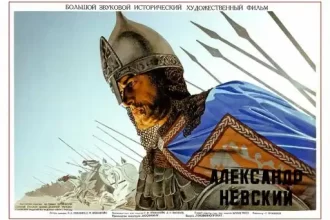Russia has a rich cinematic tradition that has produced many iconic films over the years. From epic dramas to introspective character studies, Russian cinema has something for everyone. In this article, we will explore the greatest Russian movies of all time.
Battleship Potemkin (1925)
Battleship Potemkin is a 1925 Soviet silent film directed by Sergei Eisenstein. It tells the story of the mutiny of the crew of the Battleship Potemkin against their officers in 1905, and the subsequent support they receive from the citizens of the nearby city of Odessa during the failed Russian Revolution of the same year. The film is considered one of the most influential and important works of Soviet cinema, as well as a landmark in the history of world cinema.
The film is famous for its use of montage editing, a technique that Eisenstein pioneered and which became a hallmark of Soviet cinema. The film’s famous Odessa Steps sequence, in which the Czarist soldiers fire on the crowd of civilians on the steps, is a masterpiece of editing and visual storytelling. The sequence is made up of a series of fast-paced shots, each one building on the tension and chaos of the previous one, until the scene reaches its climactic and horrific end.
Battleship Potemkin is also notable for its use of non-professional actors and its political message. The film was made with a budget provided by the Soviet government, and was intended to promote Communist ideology and inspire revolutionary spirit among the masses. The film’s themes of class struggle and worker solidarity are evident throughout, and its ending, in which the Potemkin sails towards the horizon with the crew’s red flag flying, is a powerful and inspiring image of hope and defiance.
Despite being almost 100 years old, Battleship Potemkin remains a powerful and relevant work of cinema. Its innovative techniques and political message continue to influence filmmakers to this day, and its depiction of the struggle against oppression and tyranny still resonates with audiences around the world.
Man with a Movie Camera (1929)
Man with a Movie Camera is a 1929 silent documentary film directed by Dziga Vertov. The film is widely regarded as a pioneering work of the Soviet avant-garde and a landmark in the history of documentary cinema.
The film is a cinematic portrait of Soviet life in the 1920s, depicting a day in the life of a city and its inhabitants. The film has no storyline or actors and instead relies on a series of experimental techniques, such as montage, superimposition, and split screens, to create a visually stunning and dynamic depiction of modernity.
One of the most striking aspects of the film is its use of camera movement. The film’s cinematographer, Mikhail Kaufman, used a variety of innovative techniques, such as attaching the camera to a moving bicycle or a crane, to create a sense of fluidity and movement. The film’s use of editing is also notable, with Vertov using rapid cuts and montage to create a sense of energy and rhythm.
The film’s depiction of everyday life in the Soviet Union is both fascinating and poignant. The film captures a wide range of activities, from factory work to leisure activities, and the film’s emphasis on the role of the individual within the collective is a recurring theme.
Man with a Movie Camera is a groundbreaking work of cinema that continues to influence filmmakers today. Its innovative techniques and bold experimentation with the documentary form have inspired countless filmmakers, and its depiction of Soviet life in the 1920s remains a powerful and evocative portrait of a bygone era.
Ivan’s Childhood (1962)
Ivan’s Childhood is a 1962 Soviet war film directed by Andrei Tarkovsky. The film is based on the novel Ivan by Vladimir Bogomolov, and tells the story of a 12-year-old boy named Ivan who is working as a spy for the Soviet army during World War II. Ivan has lost his family in the war and is determined to do his part to help the Soviet cause.
The film is a beautiful and haunting exploration of the psychological effects of war on children. Ivan is shown as a boy who is forced to grow up quickly due to the circumstances of the war. He is both brave and vulnerable, and the film captures this duality perfectly. The cinematography by Vadim Yusov is stunning, with beautiful and dreamlike images that contrast with the brutal reality of war.
Tarkovsky’s use of symbolism is also a significant aspect of the film. The film’s dream sequences, which feature images of water and trees, represent Ivan’s lost childhood and his desire for a life without war. The film’s final shot, which shows Ivan walking away from the camera towards a group of soldiers, symbolizes his acceptance of his role as a soldier and the loss of his childhood innocence.
Ivan’s Childhood was Tarkovsky’s debut feature film, and it established him as one of the most important and innovative filmmakers of the 20th century. The film won the Golden Lion at the 1962 Venice Film Festival and was a critical and commercial success. Ivan’s Childhood is a must-see film for anyone interested in the history of cinema or the human experience of war. It is a beautiful and moving film that captures the horror and tragedy of war through the eyes of a child.
Andrei Rublev (1966)
Andrei Rublev is a 1966 Soviet historical drama film directed by Andrei Tarkovsky. The film is loosely based on the life of the 15th-century Russian icon painter Andrei Rublev and tells the story of a country torn apart by war, famine, and religious strife. On the list of the all-time greatest films, it was ranked at number 67 by the British Film Institute’s Sight and Sound Poll.
The film is a sprawling epic that explores the nature of art, faith, and humanity. Tarkovsky’s masterful use of imagery and symbolism is on full display in Andrei Rublev, and the film’s themes are conveyed through a combination of stunning visuals, haunting sound design, and powerful performances.
One of the most striking aspects of the film is its depiction of medieval Russia. Tarkovsky and his team went to great lengths to create an authentic and immersive world, and the film is full of meticulously crafted sets, costumes, and props. The film’s battle scenes are particularly notable, with Tarkovsky using long takes and fluid camera movements to create a sense of chaos and confusion on the battlefield.
The film is also notable for its structure. Rather than following a traditional narrative arc, the film is divided into several loosely connected episodes that explore different aspects of Rublev’s life and the world around him. The film’s most powerful scenes are often its quietest, with moments of contemplation and reflection that invite the viewer to ponder the film’s deeper themes.
Andrei Rublev is a challenging and complex film that rewards careful attention and contemplation. Its exploration of art, faith, and humanity is universal, and the film’s themes continue to resonate with audiences today. The film’s final scene, in which Rublev is shown painting a fresco of the Last Judgment, is a powerful and moving tribute to the power of art and the human spirit.
Mirror (1975)
Mirror is a 1975 Soviet film directed by Andrei Tarkovsky. The film is a meditative, autobiographical work that weaves together memories, dreams, and historical events to create a deeply personal and poetic portrait of the director’s life and the history of Russia in the 20th century.
The film is structured around a series of loosely connected episodes that jump back and forth in time, featuring the perspectives of different characters and presenting a non-linear narrative. The film is deeply introspective, exploring themes of memory, childhood, motherhood, war, and the passage of time.
Tarkovsky’s use of symbolism and imagery is particularly striking in Mirror. The film features several recurring motifs, such as water, fire, and mirrors, that serve as metaphors for the film’s themes and help to create a dreamlike atmosphere. The film also features several stunning and memorable sequences, such as a haunting scene in which a burning house collapses into a river and a surreal moment in which a horse suddenly appears in a living room.
One of the film’s most notable features is its use of color. Tarkovsky and his cinematographer, Georgy Rerberg, used a unique color grading process that gives the film a distinctive, muted color palette. The colors are deliberately washed out and desaturated, giving the film a melancholy, dreamlike quality.
Mirror is a challenging and complex film that rewards careful attention and contemplation. Its non-linear structure and unconventional storytelling may be difficult for some viewers to follow, but its visual beauty, emotional depth, and poetic sensibility make it a must-see for fans of world cinema.
Stalker (1979)
Stalker is a 1979 Soviet science fiction film directed by Andrei Tarkovsky. The film is based on the novel Roadside Picnic by Arkady and Boris Strugatsky and tells the story of a “stalker,” a man who guides others through a mysterious and dangerous zone that is rumored to grant wishes to those who enter it.
The film is a haunting and enigmatic work that explores themes of faith, hope, and the human condition. Tarkovsky’s masterful use of symbolism and allegory is on full display in Stalker, and the film’s themes are conveyed through a combination of stunning visuals, haunting sound design, and poetic dialogue.
The film’s depiction of the zone is particularly striking. The zone is a mysterious and foreboding place that is both beautiful and deadly. It is a place of both wonder and terror, and Tarkovsky’s camera captures its otherworldly nature perfectly. The film’s use of color is also notable, with the zone depicted in vivid and surreal hues that give the film an otherworldly feel.
Stalker is a slow and deliberate film that rewards patient and attentive viewing. Its exploration of the human psyche and the search for meaning and purpose is universal, and the film’s philosophical and metaphysical themes continue to resonate with audiences today. The film’s ambiguous ending, in which the stalker’s daughter displays telekinetic powers, leaves much open to interpretation and has inspired countless debates and discussions among film scholars and enthusiasts.
Stalker is a masterpiece of science fiction and a powerful work of art that deserves to be seen by anyone interested in the intersection of philosophy and cinema. Its haunting imagery, poetic dialogue, and profound themes make it one of the greatest films of the 20th century.








